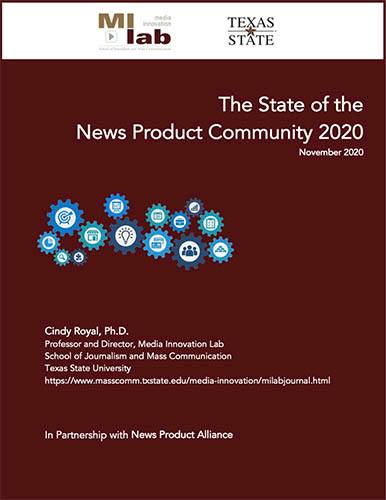Report

The State of the News Product Community 2020
Executive Summary
Digital technologies have had a vast influence on the ways we communicate, share, live and work. They also introduce news ways to produce and disseminate news, and new roles in news organizations have emerged that support a range of digital features, including content management, audience engagement, interactivity, multimedia, analytics and data visualization. Media companies, once focused on a single product (a newspaper or television broadcast) now work on multiple external and internal products – websites, content management systems, mobile apps, chatbots, interactive story presentations, podcasts, newsletters, experiments with virtual and augmented reality and more. Along with the requirements of these products come new sets of skills and competencies to coordinate, develop, manage and support them. These product managers and product-adjacent functions are the focus of this report.
Researchers are just beginning to study product management as it relates to journalism. Royal (2017) first studied this function as it began to emerge, interviewing 14 people about the role of product in media in 2016. In 2020, a forum of scholars explored a breadth of issues associated with product management in journalism and academia (Royal, et al., 2020). Other studies have looked at best practices for product professionals in media (Sonderman, 2016), new roles for journalists in data, analytics and social media (Kosterich & Weber, 2019) and managing technology resources in news organizations (Kosterich, 2020). In November 2020, the Northwestern University Knight Lab launched a series of articles on product thinking in journalism (Gallo, 2020).
The product function in media has progressed over the past few years with training programs, conferences and organizations. The University of Texas Knight Center for Journalism in the Americas has offered two product-thinking courses since 2017 (Knight Center, 2017; Mioli, 2019). The Craig Newmark Graduate School of Journalism in conjunction with NewsCatalyst offers professional and executive programs in product concepts (Newmark J-School Staff, 2020). In April 2019, a small group of product leaders met in Dallas, Texas to address ways in which the profession could better support product thinking in news. This resulted in the SRCCON:Product conference, convening 225 news product professionals in Philadelphia in February 2020. In September 2020, the News Product Alliance (NPA) was launched to build “a community of support and practice for news product professionals and product thinkers.”
All these activities point to a function that is growing, in flux and in need of further definition and identification as it relates to journalism and media companies, so this is an appropriate time to learn more about its actors. This study is the first extensive analysis of product professionals and product thinking in media organizations. To gain insight into product and related roles and the intersections at which they operate, a survey of news product professionals was launched, in conjunction with NPA. Starting September 23, 2020, product professionals were invited to join the NPA community via an email list of product-related personnel gathered through product-focused events. When a user provided their name and email address on the website, a follow-up email was sent, inviting them with a link to complete the survey. Of the 1074 who joined the community by October 9, 2020, 297 completed the entirety of the closed-ended questions of the survey, a 28% response rate. The survey included 30 closed-ended and 6 open-ended questions that inquired about backgrounds, work history and perceptions of the position of product management in the news industry.
Report Highlights:
- The survey results offer an idea of what the product community looks like demographically. The community is equally represented by gender with men making up 49% and women at 51%, although gender discrepancies exist across some position categories. Most people fell into the 25-34 (37%) and 35-44 (37%) age groups, with slightly more men than women in the 45-54 age group, which made up 16% of the survey.
- The survey indicated that the community needs diversity improvements: 70% of respondents identified as White, with Hispanic/Latinx, Asian and Black respondents each comprising less than 10%.
- More than 2/3 of respondents don’t have “product” in their title, indicating a range of titles involved in the function. While 55% described their job as a product role or an editorial or revenue bridge role, the community also includes data scientists, news executives, journalists, technologists and others.
- Almost two-thirds of the respondents said their specific positions did not exist five years ago, and nearly 90% have been in their current role for less than five years. Even those who identified as journalists were likely to say their particular role didn’t exist five years ago (71%). This indicates an emerging field with career development implications.
- More than half of respondents indicated that their organization had a dedicated product team. However, 13% of respondents did not provide an answer to this question and another 13% responded “I think people are doing this work without the titles or resources” or “Not sure.” This indicates a general level of uncertainty about how product roles are organized.
- Descriptions of job functions represented the themes of “intersections” and working across “multiple functions.” But some statements continue to uphold more traditional descriptions of these roles as “support” functions or in opposition to “content-producing” roles.
- Fewer agreed with the statement “My organization's products demonstrate diversity and inclusiveness of the audience” (48%) than “My organization's products demonstrate journalistic ethics and responsibilities to the audience” (78%). This data point reinforces the need to bring more diverse perspectives into this profession, as Hispanic/Latinx, Asian and Black respondents were more likely to agree with the diversity and inclusiveness sentiment than White respondents.
- The community is global. While the majority of respondents were from the U.S. (54%), the survey received responses from 32 countries with 10% from Germany and 8% from Brazil.
- The top requested tool or skill development areas in the survey were “career development,” “organizational management” and “cultural change,” confirming the need for the support of more strategic than hard skills.
 Download the Full Report - The State of the News Product Community 2020.
Download the Full Report - The State of the News Product Community 2020.
